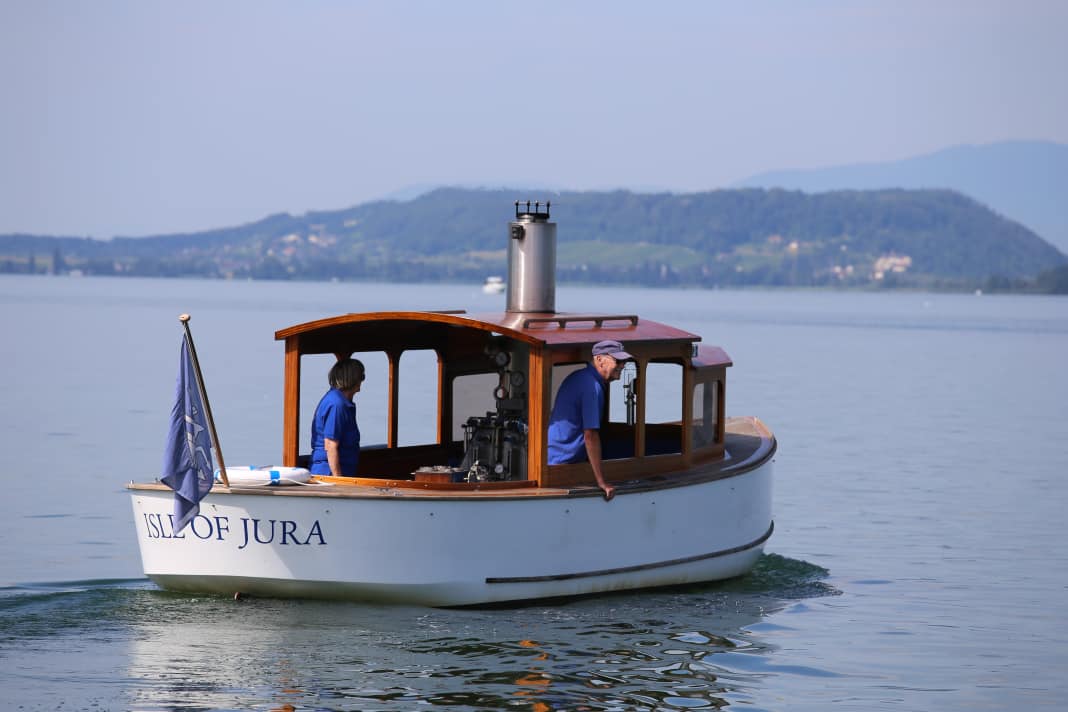





- Read the first part of the report here: Nostalgia at the foot of the Jura - The "St. Urs" - Switzerland's oldest steamboat
Around 40 kilometres upstream, on the southern shore of Lake Biel, these same steamboat enthusiasts, Ralph and Isabelle Sahli, are preparing their "Isle of Jura" for a trip. Apart from the basic principle of propulsion by steam, the "Isle of Jura" doesn't have much in common with the "St. Urs". The hull, which is only 22 years old, comes from a shipyard on Lake Constance and was built a metre and a half longer than usual for this type of boat on Ralph Sahli's behalf in order to create space for the boiler and engine. In this case, the latter is an in-house design.
Together with his father, the mechanical engineer milled, drilled and tinkered in the company's own precision engineering workshop. "The cylinders were raw castings from a garden railway locomotive," says Sahli. "I already had some experience with steam locomotives. On a trip to Brienz at the end of the 1990s, we happened to barge into a steamboat meeting. And then I was hooked, so to speak." Much to the delight of his wife Isabelle: "He was actually planning to buy himself a Harley for his 50th birthday. Instead, he got a steamboat. I much preferred that." Steamboating became a shared hobby. Also because you always need two people to drive: one to steer and one to heat. The expertise was quickly acquired. Two or three trips - and the Sahlis knew how to do it.
Dry beech wood and water - that's all a steam captain needs
Because they are so environmentally friendly, steamboats are also allowed to travel on drinking water lakes. As beautiful as the Swiss lake district is, every now and then the Sahlis pack their "Isle of Jura" onto the trailer to explore foreign waters. They have already travelled under steam on Lake Constance, the Moselle, the Lahn and even off the coast of Monaco. "The Classic Week in Monaco was something different, with the swell and salt water," says Isabelle Sahli. "We had a freshwater tank at the front to fill the boiler." Most of the time, however, the "Isle of Jura" is travelling at the foot of the mountains that are also in its name. The Sahlis often go on trips with other steamboaters, such as the Schmids, to anchor and swim on Lake Neuchâtel and Lake Murten. "The beauty is the enforced slowness," explains Ralph.
You have to adapt your timing to the technology. You can't just get on board, turn the key and set off. It takes a good three quarters of an hour to fire up the boiler. In that time, you just have another beer.
The art of anticipatory heating
Heating is an art in itself. If you were to heat up too quickly, the hot vapour would condense in the still cold machine. The machine is warmed up slowly by gradually opening the valves. Safety valves ensure that the pressure does not rise too high. In the worst case scenario, the cylinder block could split. A respect-inspiring idea for laymen. But the Sahlis are deeply relaxed and trust the design 100 per cent. In contrast to the "St. Urs", the "Isle of Jura" does not have an external condenser, where the water is cooled through a copper pipe on the outside of the ship, but an internal condenser. The cooled water is fed back into the boiler via a pump. The closed water circuit is the basic principle of all steamboat engines. Only a small amount of steam is lost through the chimney when the steam is "let off".
"The most important thing about steamboating is to sail with foresight," explains Isabelle Sahli. "If the pressure rises because you're constantly reheating, you can't just stop to anchor. We let the boiler cool down in good time before we want to moor. But of course not so much that we can no longer reach our destination. That's the trick. You can't wait long for late passengers when you leave. At some point you have to cast off or lose all your energy by whistling again. That's not what you want. But at least a few passers-by are happy."
The Swiss Steamboat Friends Association has around 140 members and around 40 steamboats, although not all of them are operational. The community meets regularly to go out together and exchange ideas. "And every boat is different, no two are exactly the same," enthuses Ralph Sahli. Seeing other people's interest in and fascination with steamboats has prompted the Sahlis and Schmids to organise commercial trips: As part of an owners' association, they offer trips on the historic steamboat "Sirius", which incidentally also comes from the Harburg castle shipyard. Two to three times a week during the season, they take a full boat out onto Lake Murten. Most of the guests are tourists. Nostalgia, cosiness and tangible, visible technology: that's what attracts them. And the fact that there is always something to do or look at: reheating, checking the pressure and water level, oiling the machine. And all this against the idyllic backdrop of the Jura mountains, which stretch along the western shores of the three lakes.
- Read the first part of the report here: Nostalgia at the foot of the Jura - The "St. Urs" - Switzerland's oldest steamboat

